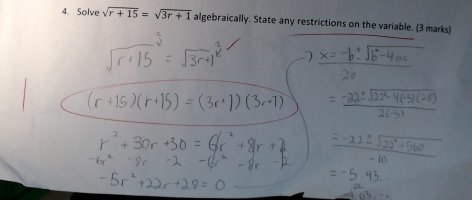You are using an out of date browser. It may not display this or other websites correctly.
You should upgrade or use an alternative browser.
You should upgrade or use an alternative browser.
Wondering how I got this part wrong ("solve algebraically. state any restrictions on the variable")
- Thread starter reddec85
- Start date
Cubist
Senior Member
- Joined
- Oct 29, 2019
- Messages
- 1,666
You squared both sides of the equation twice. This isn't necessary, but it doesn't account for the incorrect result (it will introduce extra results but these can be eliminated by plugging values back into the original equation). Your major mistake lies on the line after the red circle because...
[math]3r \times 3r \ne 6r^2[/math][math]15 \times 15 \ne 30[/math][math]3r+3r \ne 8r[/math][math]1 \times 1 \ne 2[/math]
I stopped reading after this point. You need to practice multiplying out brackets. Perhaps see https://www.freemathhelp.com/using-foil/
[math]3r \times 3r \ne 6r^2[/math][math]15 \times 15 \ne 30[/math][math]3r+3r \ne 8r[/math][math]1 \times 1 \ne 2[/math]
I stopped reading after this point. You need to practice multiplying out brackets. Perhaps see https://www.freemathhelp.com/using-foil/
Dr.Peterson
Elite Member
- Joined
- Nov 12, 2017
- Messages
- 16,089
None of your work, apart from indicating that you are going to square both sides (which is not what you did) is useful.Seems like I got a good start on this question, but what went wrong here? Thanks in advance for any help.View attachment 30800
But do you see how to determine the restrictions on the variable, before you do anything else? What is implied by square roots?
Otis
Elite Member
- Joined
- Apr 22, 2015
- Messages
- 4,414
Hi reddec. Yes, squaring both sides is a good start, but you didn't do that correctly.Seems like I got a good start on this question, but what went wrong here?
When we multiply a square root by itself, we get the radicand. The radicand is what we call the expression inside the radical sign.
For example, given the square root [imath]\sqrt{r+15}[/imath], the radicand is [imath]r+15[/imath].
Let's square that square root:
\(\displaystyle (\sqrt{r+15})^{2} = (\sqrt{r+15})(\sqrt{r+15}) = r + 15\)
Please try solving the equation again.
[imath]\;[/imath]

